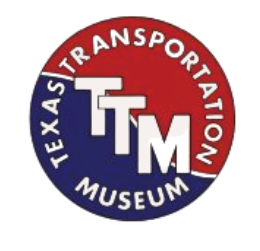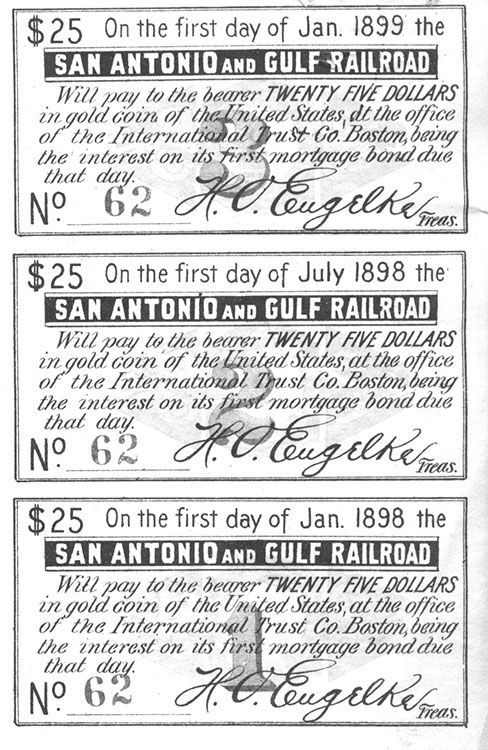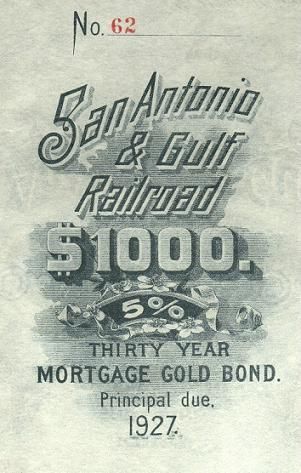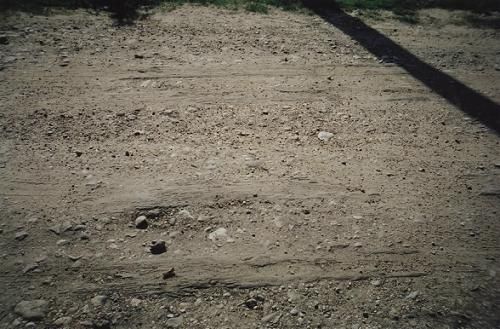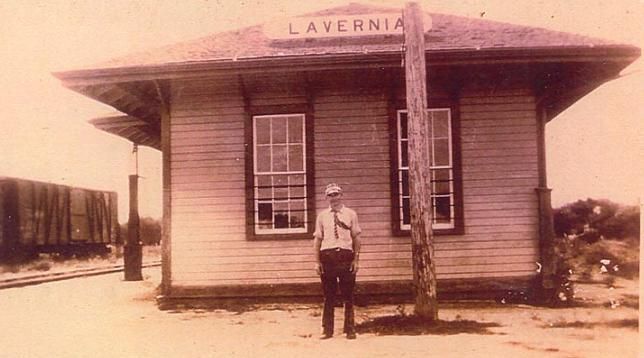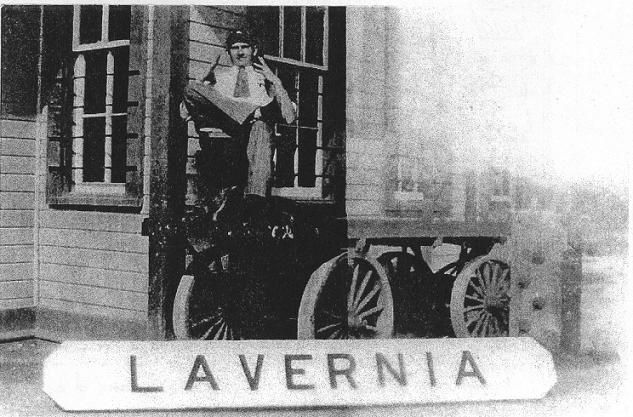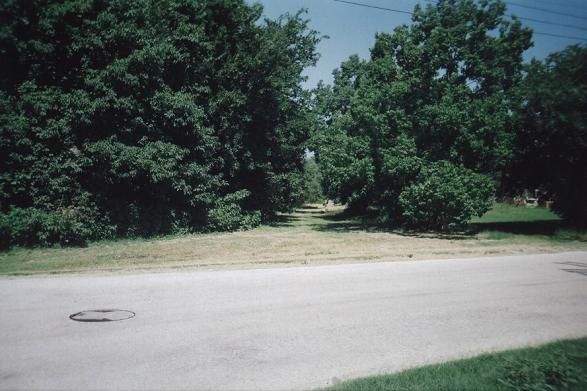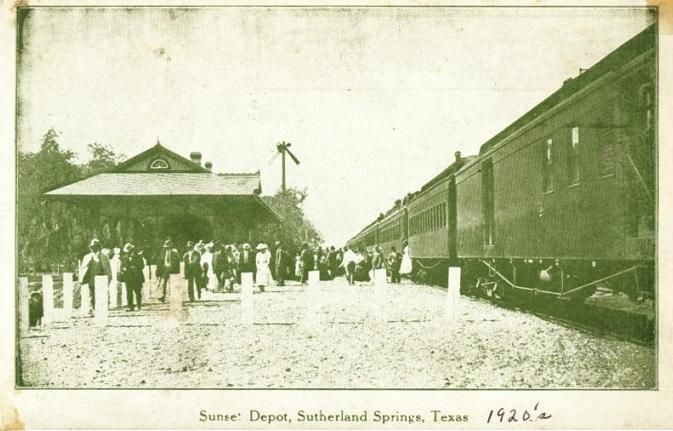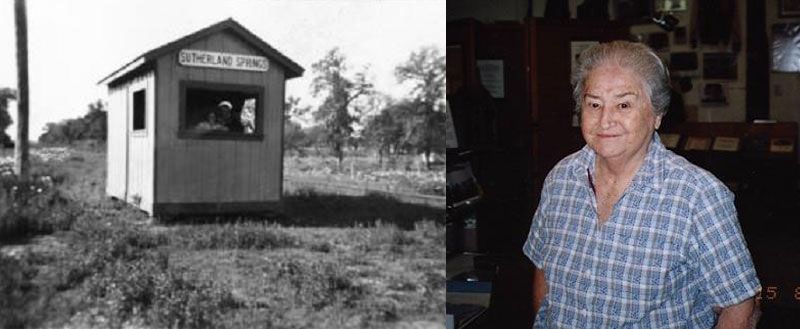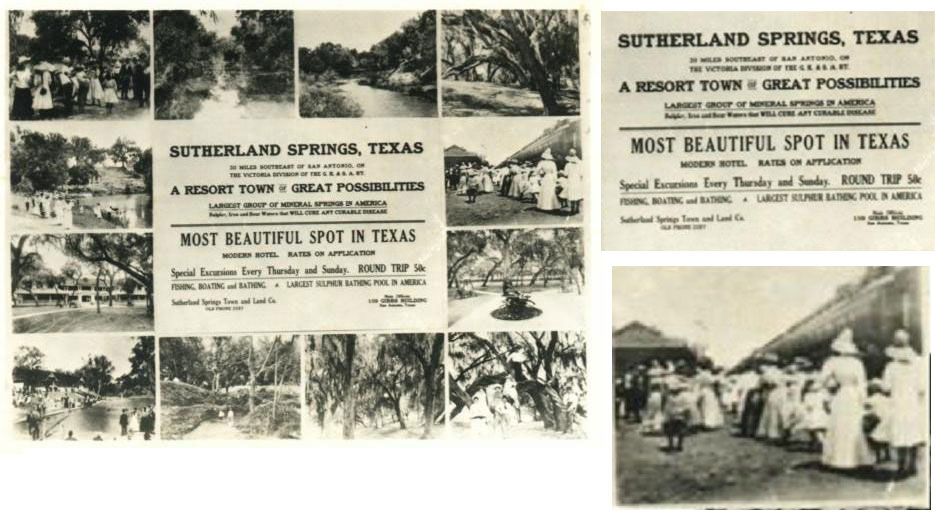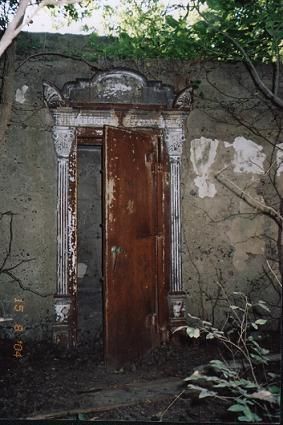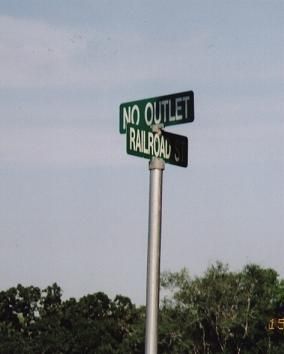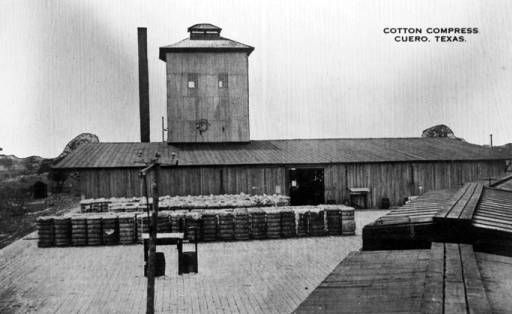San Antonio and Gulf Shore Railroad
We are indebted to the Lavernia Historical Association.
This group, formed in 2002 has already performed great work towards preserving the heritage of this historic town first settle around 1853. Its president, Elaine Mazurek, has been of inestimable assistance, providing photographs and county maps that show light on other towns served by the railroad.
We are also indebted to the Sutherland Springs Museum, which is open on the first Saturday of every month.
The San Antonio and Gulf Shore Railroad is perhaps the most overlooked railroad that originated out of San Antonio. It was begun in 1893. Like many railroads, it was begun with very ambitious plans. As with the Galveston Harrisburg and San Antonio in 1877, and the San Antonio & Aransas Pass in 1884, it was hoped the new railroad would reach a deep water port in the Gulf. By 1896, the company had reached Sutherland Springs, some 26 miles. It owned two locomotives and sixteen cars. But with earnings as low as $400 for passengers and $600 for freight, the company was forced to foreclose.
To make matters worse, the group of investors that started the railroad soon disintegrated in bitterly opposed factions which led to nasty court battles and the loss of several fortunes of some very prominent men. One of these was former Texas Governor, John Ireland, of Seguin, who lost his entire estate of $200,000 and died not long after. S.G. Reed covers the episode quite extensively in his 1941 book, "The Railroads of Texas." In 1894, the railroad was using a very old wood burning locomotive. After the train left the (G.H. & S.A.) depot on Austin Street, it had to stop every few miles to take on more wood. It took five to six hours to reach Lavernia, The crew, Jud and Jes Fry, combining the roles of company President, Conductor, Engineer, and Brakeman, would pass the time playing poker in the railroads "General Office," the caboose.
A new company, backed by the Southern Pacific, was formed in 1897 and called the San Antonio & Gulf. The new company extended the main line by six miles and reached Stockdale the same year. They also added some spur lines. One went to Cibolo from Sutherland Springs and another from Lavernia to some sand pits. By 1903, they reported owning two locomotives and eighteen cars. They had $15,000 in passenger earnings and $46,000 from freight. In 1905, the Southern Pacific was authorized by the legislature to acquire the company and it was folded into its Galveston Harrisburg & San Antonio's Victoria Division. As part of the take over, the S.P. agreed to extend the line to Cuero, another 46 miles.
Reaching Cuero was an important step forward for the line and ensured its long term viability. Cuero was already served by the San Antonio & Aransas Pass, on its line between Kenedy and Yoakum. The S.P. also had a line to Cuero from Victoria. It had been built in 1873 by the Gulf, Western Texas & Pacific railroad, the successor to a company called the San Antonio & Mexican Gulf, which dated back all the way to 1850. In a way the addition completed the original plan, albeit fifty seven years later and under completely different companies. The extension created a direct line between Victoria and San Antonio. With the S.P.'s de facto control, and later full ownership, of the San Antonio & Aransas Pass, the giant railroad had a full grid network in coastal Texas.
1938 Wilson County map details, showing La Vernia (Lavernia), Sutherland Springs and Stockdale.
For all intents and purposes, the railroad follows the route of HWY 1346, which starts as East Houston Street and ends at HWY 87, just north of Lavernia. A stub of the line still exists. It terminates just inside Loop 410 at East Houston. Along its route, some of the communities served by the railroad have risen and some have fallen. The line crosses from the north of the highway at Martinez, which today has a population of around 100, to the other side and headed to a small community called Saunders. There may have been an opportunity to get on and off the train in Martinez - no details exist. Edmund Ebrom, who wrote a letter of inquiry to Paula Allen, who writes a local history column in the Sunday San Antonio Express News, recalls traveling on the train in 1940, when he was about five years old. He says there was no depot as such, just a railroad section house and a small platform for passengers. Adkins, the next stop on the line, definitely had a depot. (We are still looking for pictures of it.) Adkins is located on the edge of Loop 1604, and abuts St. Hedwig. St. Hedwig is now the bigger of the two communities. It has seen just about all of its growth, as a dormitory town, since the railroad was removed in 1971. The black & white railroad map shows every stop and siding and so is not a good guide where depots may have been located. You can see Carpenter on the 1958 colored map on this page but it is now a very small community indeed. On a dirt road just north of HWY 1346 there are some visible railroad ties still in the ground. It is rumored that the old railroad section house is still in its original site in Carpenter, so more sleuthing is probably in order.
Lavernia, however, is doing well. It was founded in 1851 and has seen steady but hardly meteoric growth over its 150 year history. It was able to incorporate in 1980, and has a population of around one thousand. It is the center of its own school district. It had a good sized depot, and a number of businesses used rail service for the transportation of their goods. These included the town cotton gin. The tracks went right by the company's buildings and you can see an exposed tie or two on the edge of the road to this day and the route the tracks took through the town are quite obvious from there. By 1915, the town had two gins, a pottery plant of some distinction and a brick works.
In 2002 the Lavernia Historical Association was formed, so that the town's history would be collected and celebrated. In the first edition of "LAVERNIA LEGACIES," the town's railroad history was featured prominently and the chapter is very grateful to the Association for their generous permission to reproduce several pictures here. The pictures come from Helen Freeman who also provided some reminiscences for the magazine starting around 1917. She recalled that the depot was the place you called to get the accurate time. Household clocks and watches were not so accurate in those days but the railroad clock was under government mandate to be correct and was inspected on a monthly basis to ensure it remained on time. The depot also held the town's telegraph station. It was also the place that mail was delivered to and picked up from. The depot was segregated, if you can believe that so relatively small a structure could accommodate the duplication. Cattle tended to be moved at night and their plaintive mooing could be heard as you tried to sleep. Troops were moved on this line from San Antonio to Houston during World War One, and Ms. Freeman, then a girl of eight, would go to the depot to wave and cheer them on. She traveled to San Antonio with her mother quite often up to 1918. She made her last trip by train from Lavernia in 1947, to visit her brother. She took her three children with her. The Association is to be commended for their efforts. Everyone benefits when these personal touches can be added to the harder, colder facts of history.
Sutherland Springs probably had the most success from the arrival of the railroad. As a good example of how sometimes whole towns can be mobile, most everyone left the town's original site, once the county seat, and moved to New Sutherland Springs, nearer to the railroad depot on the east side of the river. The town was a tourist destination and supported a grand 52 room hotel plus other related businesses. By 1923, the tourist boom was over, the hotel was closed and ultimately demolished. Following the construction of HWY 87 near the town's original site, most residents moved back, and the site of "New" Sutherland Springs has been returned to agriculture.
The area was first settled in 1949 by John Sutherland who originally named the place Sulfur Springs. The post office notified him that the name was already taken and it was changed in 1851. The town was flourishing by 1860, including tourism to the many wells in the area. The town was selected by the state legislature to be the county seat of newly formed Wilson County but this distinction was lost when nearby Floresville was chosen by popular vote in the late 1880s. As usual in these cases, there was a bitter fall out over the decision, which was shaped in part by the fact that Floresville was on the railroad, the San Antonio & Aransas Pass, and Sutherland Springs was not. The change of county seat for this reason was fairly common at this time such was the importance of rail service.
As mentioned, the railroad ran on the east side of Cibolo Creek, a good distance from the center of the town. After some legal difficulties, the Sutherland Springs Development Corporation platted out a new town on the other side of the river and, due in large part to the popularity of the various springs and the resulting tourism, New Sutherland Springs began to outgrow the original town site and a number of the old town's businesses moved to the new site. The area took on the slogan of "The Saratoga Of The South." It is said that not only did people from all over the USA come to take the healing waters, many traveled from as far away as Europe to do likewise. The hotel did good business and the pools and bath houses also did good trade. A bank was located in the town along with a cinema for evening entertainment. Regrettably a flood in 1913 all but demolished the bath houses and the pools. Changing recreational tastes and the outbreak of World War One did not help and the town's renown as a tourist destination was soon to fade.
In 1914, however, these thoughts were far from the mind of Thomas Williams who bought the town site and rebuilt the bath houses. He built an extension from the main line right to the pools. The line went right behind his hotel as well so there was virtual door to door service for the infirmed. In those days people also traveled with an almost inconceivable amount of luggage so being closer to the train was of probably a great relief for all concerned. Soon Southern Pacific was running two trains a day to Sutherland Springs for the princely fare of 50 cents return. The first train left at 8:30 AM and arrived at Sutherland Springs depot at 9:50AM and the baths ten minutes later. It headed back at 10:30 AM and reached San Antonio by 12:00 noon. The second train departed at 2:00 PM and reached Sutherland Spring depot at 3:20 PM and the baths at 3:30 PM. It began its return at 4:30 PM and reached San Antonio at 6:00 PM. As a small matter, both depots in Sutherland Springs and San Antonio rejoiced in the same name, "Sunset." In fact, the chances are that the one in Sutherland Springs was given the name first, as the far grander STATION in San Antonio was not opened until 1903, whereas the depot in Sutherland Springs was probably completed earlier. While this is only conjecture, one can wonder if Southern Pacific would allow the double use of the name under any other circumstances.
Additionally, Sutherland Springs had saw mills, a cotton gin and agricultural produce such as water melons, for which the railroad would leave a car to be filled in time for the next train. The Sutherland Springs Sand Company was another bulk user of the railroad. On a spur track near Railroad Street, it had a pump capable of filling a car in as little as twenty minutes. These businesses did well but the tourism peak soon ended, and the hotel closed its doors to the public in 1923. By 1941, the depot was sold to a private owner who relocated it to nearby Stockdale where it can still be found today, substantially rebuilt but still recognizable. In its place the railroad installed a curious booth like waiting room which was a popular place for local kids to play in. Following the improvements to HWY 87, which went through the site of "Old Sutherland springs, the new town faded away and now you can hardly find a trace of it. To add injury to insult, when the road to Seguin, FM 539, was improved it was run right through the site of the once grand Sutherland Springs hotel.
This line was one of the first to be abandoned in this region. Passenger trains probably ceased in the early 1950s. All remaining traffic had ceased by the end of the decade. The S.P. maintained the line from Cuero to Stockdale longer than the rest but this too was pulled up by the mid 1970s. According to a landowner in Carpenter, the abandoned tracks stayed in place, unused, until the mid 1960s. The rails themselves were taken away by the railroad but the ties were offered to local residents. All the trestle bridges were dismantled to remove any liability to the railroad. Places where the tracks had crossed over the highway were re-paved. Soon enough, landowners began removing many embankments to allow for a return to productive agricultural use or other aesthetic reasons. Today there is almost no trace that a railroad was ever there and just about everyone has forgotten about it. Within San Antonio it is next to impossible to find a trace of the line that paralleled Houston Street and even exactly where it joined the main line is an open question. The old SA &GS has only managed to achieve the rarest mentions in any books about railroading in the area. We hope to find more information and, of course, more pictures. A little more attention seems to be being paid to this fascinating line and we are glad to be a part of this resurgence of interest.
Information Sources:
The Texas State Historical Association Online
S.G. Reed, "The Railroad of Texas," published 1941
The Lavernia Historical Association
The Sutherland Springs Museum
John Decker, Fire Chief, St. Hedwig VFD, (Former Chairman of Texas Transportation Museum)
San Antonio & Gulf Shore Railroad Timeline
━━━━━━━━━━━━━━━━━
1894
The San Antonio & Gulf Shore Railroad is created
━━━━━━━━━━━━━━━━━
1894
Following internal disputes, the board of the SA & GS is reconstituted with new investors following the departure of some orignal backers. Tracks are built as far as Sutherland Springs where the sulphur springs attract an international clientele.
━━━━━━━━━━━━━━━━━
1897
Under the auspices of the Southern Pacific, the railroad is re-formulated once again, as the San Antonio & Gulf. The tracks are extended to Stockdale.
━━━━━━━━━━━━━━━━━
1905
The Southern Pacific is allowed to take complete control of the the SA & G and the line is folded into the SP's "Galveston, Harrisburg & San Antonio" division. The tracks are extended to Cuero where they meet up with other SP lines, making the old SA & G line far more viable.
━━━━━━━━━━━━━━━━━
1947
Passenger service on the old SA & G line comes to an end
━━━━━━━━━━━━━━━━━
1960
Freight service on the old SA & G line comes to an end.
━━━━━━━━━━━━━━━━━
1965
Tracks from San Antonio to Stockdale pulled up. Land owners are offered to old railroad ties.
━━━━━━━━━━━━━━━━━
1975
Tracks between Cuero and Stockdale also pulled up
Transportation Museum
CONTACT US TODAY
Phone:
210-490-3554 (Only on Weekends)
Email:
info@txtm.org
Physical Address
11731 Wetmore Rd.
San Antonio TX 78247
Please Contact Us for Our Mailing Address
All Rights Reserved | Texas Transportation Museum
